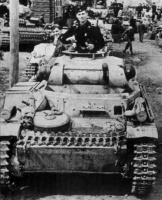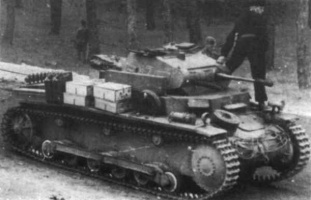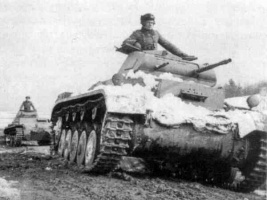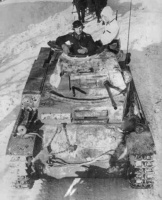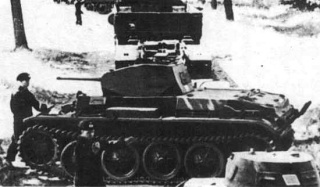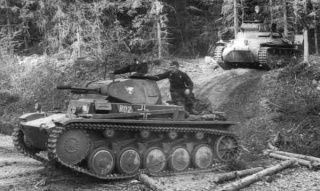Pz.Kpfw. II
PzII (Stock)
| 3000 Coût |
| 230 PSDurabilité |
| 9.31 / 10.8 Poids |
- Chef de char
- Tireur
- Pilote
- Chargeur (Opérateur radio)
| 30/20/15Blindage caisse(avant/flancs/arrière, mm) |
| 30/15/15Blindage tourelle(avant/flancs/arrière, mm) |
| 160 chPuissance moteur |
| 40 km/hVitesse maximale / en marche arrière |
| 49 °/sVitesse de rotation |
| 12 damage |
| 23 mmPénétration moyenne |
| 7.2 Temps pour un chargement complet |
| 39 °/sVitesse de rotation du canon |
| 220 mPortée de vue |
| 500 mPortée du signal radio |
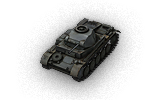
The Pz II is a German tier 2 light tank
This tank combines good speed with excellent maneuverability, and boasts 30mm of armor on the front hull and turret. It's one of the few tanks in the game that can only use auto-cannons. Its 2 cm Flak 38 L/112 auto-cannon can penetrate nearly every other vehicle at its tier or below, and well-aimed shots can penetrate most tier 3 tanks. As with most tanks of its tier, the Pz.Kpfw. II is easily upgradable and it's a tank that is a lot of fun to fight in, especially as the player's skills improve. A popular vehicle, you will doubtlessly face this tank many times on the battlefield.


Tourelle
| Niveau | Tourelle | Blindage tourelle (avant/flancs/arrière, mm) | Vitesse de rotation du canon (°/s) | Portée de vue (m) | Expérience | Poids (t) |
|---|---|---|---|---|---|---|
| II | Pz.Kpfw. II Ausf. b | 30/15/15 | 39 | 220 | 0 | 950 |
| Niveau | Canon | Pénétration moyenne (mm) | Cadence de tir | Dispersion à 100 m | Temps de visée | Expérience | Poids (t) | |
|---|---|---|---|---|---|---|---|---|
| I | 2 cm Kw.K. 38 | 23/46 | 12/12 | 60.5 | 0.57 | 1.6 | 0 | 70 |
| II | 2 cm Flak 38 | 39/51 | 12/12 | 69.23 | 0.45 | 1.6 | 290 | 110 |
| Niveau | Tourelle | Blindage tourelle (avant/flancs/arrière, mm) | Vitesse de rotation du canon (°/s) | Portée de vue (m) | Expérience | Poids (t) |
|---|---|---|---|---|---|---|
| III | Pz.Kpfw. II Ausf. F | 30/20/20 | 44 | 230 | 580 | 950 |
| Niveau | Canon | Pénétration moyenne (mm) | Cadence de tir | Dispersion à 100 m | Temps de visée | Expérience | Poids (t) | |
|---|---|---|---|---|---|---|---|---|
| I | 2 cm Kw.K. 38 | 23/46 | 12/12 | 60.5 | 0.57 | 1.6 | 0 | 70 |
| II | 2 cm Flak 38 | 39/51 | 12/12 | 80.9 | 0.45 | 1.6 | 290 | 110 |

Moteur
| Niveau | Moteur | Puissance moteur (ch) | Probabilité d'incendie à l'impact | Expérience | Poids (t) |
|---|---|---|---|---|---|
| III | Maybach HL 62 TRM | 160 | 20 | 0 | 550 |

| Niveau | Suspension | Limite de charge | Vitesse de rotation (°/s) | Expérience | Poids (t) |
|---|---|---|---|---|---|
| II | Pz.Kpfw. II Ausf. F | 10.8 | 49 | 0 | 2900 |

Radio
| Niveau | Radio | Portée du signal radio (m) | Expérience | Poids (t) |
|---|---|---|---|---|
| II | FuG2 | 500 | 0 | 40 |
Compatible Equipment
Compatible Consumables
Avis des joueurs
Points forts/faibles
Points forts :
- Highest penetrating auto-cannon available at this tier
- Short aim time
- Good turret traverse speed
- Accurate L/112 cannon and acceptable reload time
- Good radio range
Points faibles :
- Low penetration at long range
- Unable to hit targets above 350m
- Tier III tanks can gives you a hard time with your auto canons
- Slow hill climbing
- Weak turret armor which causes problems if attempting to hull down with this tank
Performance
This is a fun fighting tank. If you were using the Breda on the Leichttraktor then you should find this tank very similar. It can be very effective in urban environments or anywhere it can engage in short-range combat. At long range the auto-cannon is far less effective, as it has to re-aim after every two-shot burst. It carries a good amount of ammo though, so you can afford to utilize some "spray and pray" tactics. Due to this tactic coupled with its good aim time, an Enhanced Gun Laying Drive is a little useless. The Panzer II's frontal armour is above average and can easily deflect many shots from rivals that are using auto-cannons.
This tank is great fun when fighting up close. Its high RoF coupled with decent pen means it can go food (or tank)processor on other puny tier 2s. Well-aimed shots can pen nearly anything for same-tiered tanks. Although it may have somewhat sluggish speed, it's still enough to keep up with the pace of the battle. Your good armor (30 mm) can bounce quite a few shots when angled correctly. Try to avoid sniping; the autocannon's pen greatly diminishes over distance, and your accuracy is bad as well, The T18 is also a liability, but good flanking skills can overcome it with relative ease. Shooting the T18 in the front upper glacis plate will however ensure penetration and in turn cause most early players to back off due to sudden penetration from the front of the supposedly impenetrable front of a T18, giving you sufficient time to run or possibly even shoot the sides of a retreating T18. Allow M3 Stuarts to pass by you and shoot their rear or sides , as their weak spots in front cant be reliably penetrated due to their high speed. Overall, this tank is very well-rounded.
You don't need the added weight capacity from the suspension upgrade on this tank, but it adds 5 deg/s to traverse speed, so it's definitely worth getting.
With 120 RPM and 11 damage, you can do over 1,200 DPM, which is astoundingly high for tier 2.
Modules prioritaires
- Nothing carries over from the Leichttraktor.
- First research the 2 cm KwK 38 L/55 for faster rate of fire, aim time, and accuracy.
- You may want to continue on and get the 2 cm Flak 38 L/112, which features much improved penetration and accuracy.
- Next it's a toss-up between the engines and the suspension.
- Note that the turret upgrade also improves the reload time, in addition to increasing view range and hit points.
- Go from there.
Informations Historiques
The Panzerkampfwagen II (Sd.Kfz.121) was larger than the Panzerkampfwagen I, but was still a light training tank. Due to the delays in production of the Panzerkampfwagen III and Panzerkampfwagen IV, the Panzer II entered combat service as a "stop-gap" vehicle for the expanding Panzertruppen. Similarly to the Panzerkampfwagen I, it did not prove very effective in combat, although it was the main battle tank of the Panzertruppen until 1940 and 1941.
Overall, the Panzerkampfwagen II was ineffective as a combat tank but was an important step in the development of more powerful panzers. When put in good hands, the Panzer II was a good light tank and an effective light reconnaissance vehicle that provided German designers and manufacturers with more tank building experience. As with any other panzer, its chassis became a base for the usual conversions, including the Marder II tank destroyer, Wespe self-propelled howitzers, and others. Additionally, other designs utilized the same components: the Flammpanzer II Flamingo/PzKpfw II(F) flamethrower tanks, the Schwimmpanzer II amphibious tank, and the Sturmpanzer II Bison self-propelled gun.
Historical Gallery
Sources et Liens Externes
| Light Tanks | |
| Medium Tanks | |
| Heavy Tanks | |
| Tank Destroyers | |
| Self-Propelled Artillery |
| USA | |
| UK | |
| Germany | |
| USSR | |
| China | |
| Japan |
